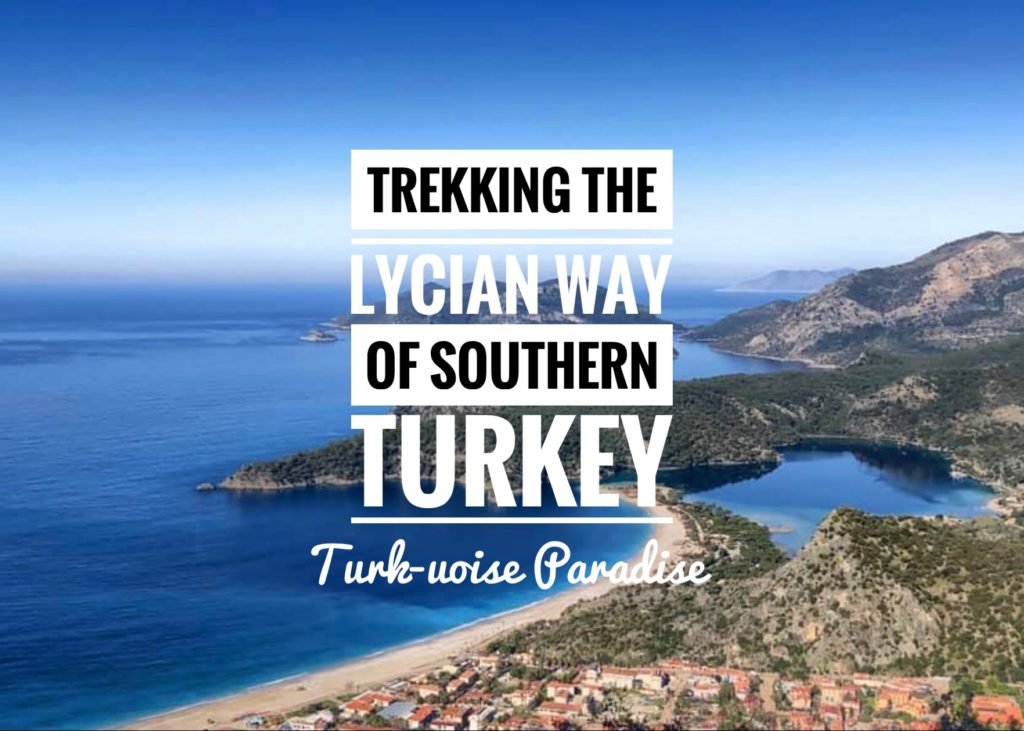
We can safely say the Lycian Way is epic… or is it magical… or…merely indescribable!?! it has blissfully undeveloped wild mountain terrain matched only by aqua seas and white limestone beaches that mesmerize and majestic old black pine and cyprus tree forests grow alongside ancient olive groves clinging to life on terraced cliffs. The serene mountain hamlets and hidden under-any-radar coastal villages beckon you to stay “just one more day,” there are wonderful colorful and truly kind people here who offer you mouth-watering food, every time! Oh, and you literally stumble over ancient Lycian ruins that are 2,500 years old… dating from 500 BC.
We found all this in about 100k in 7 days of walking, to complete the Lycian Way is to hike 540k (335 miles) in about 30-days. We aren’t saying we’re quite finished with the trail just yet (And we don’t say that about many places.) Our trek started when we abandoned our mobile homes (aka our behemoth backpacks) with our Airbnb host in Antalya for 2 weeks, and consolidated our essential gear into our much smaller daypacks. Then hopped on a bus to go four hours west ($7/each) to the town of Ölüdeniz, often deemed “Little London” due to the mass quantities of retired Brits who have brilliantly set up residence here in this little paradise.
Of course it didn’t take us long to start to fantasizing about setting up shop here. Unfortunately our bed and brew dreams got a bit quashed when we found out how difficult it is for foreigners to set up a business here, at least not without divorcing and shacking up with Turkish spouses.
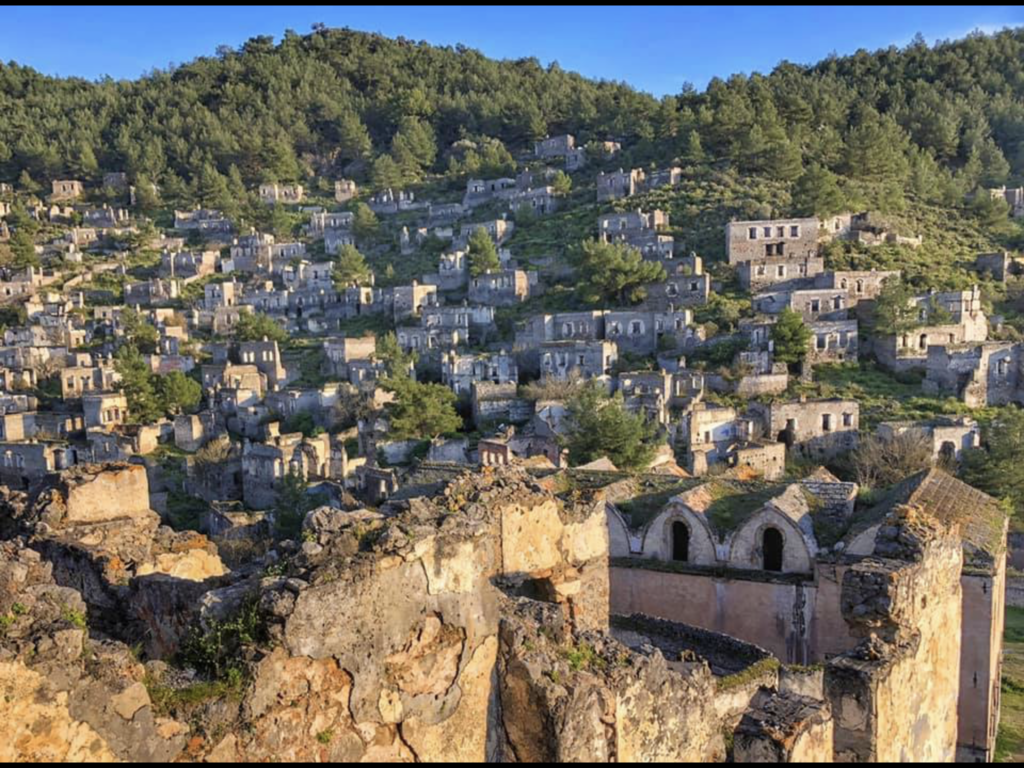
From Ölüdeniz, we had some extra time when we arrived, so we got our hiking shoes worn in on a quick 4K Lycian Way off-shoot trail to the ruined village of Kayaköy, which we were amazed to find is a massive 4,000 building ghost town originally built in the 1700’s. Due to a messy post WWI fallout and the collapse of the Ottoman Empire, the village, where Muslims and Christians lived in harmony for centuries was abandoned in 1923 when its 10,000 historically Greek residents were forced to flee to Greece. An earthquake in 1957 further dilapidated the town’s existence.
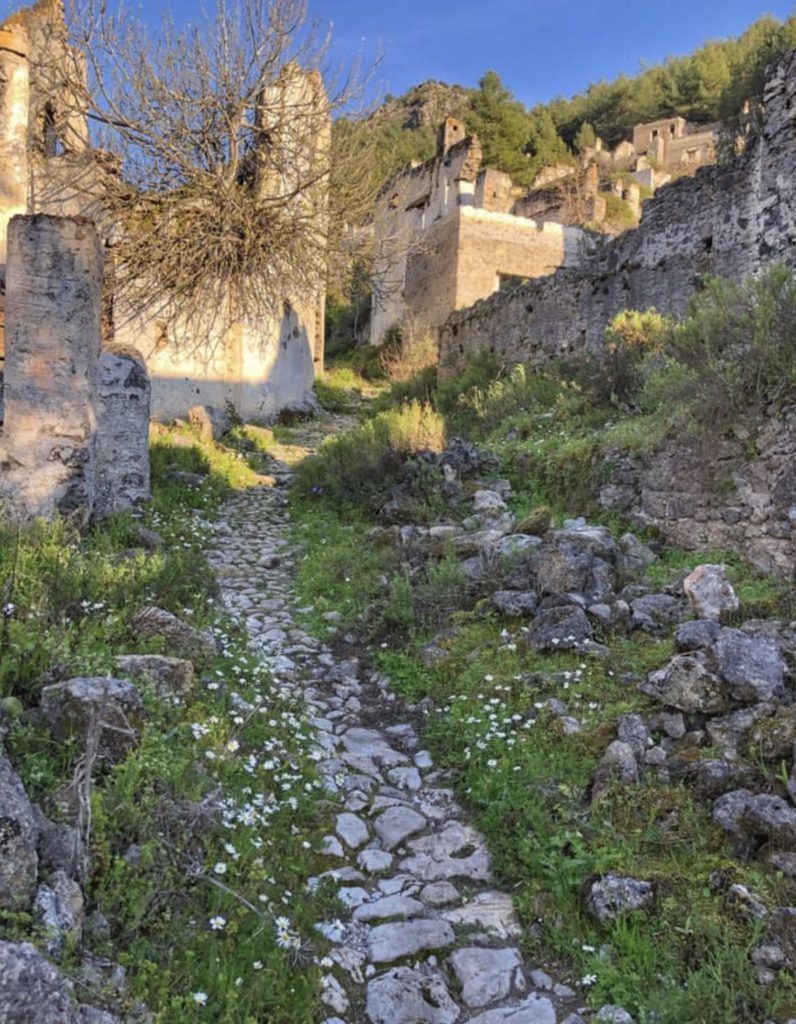
Wandering into the eerily desolate streets of the Kayaköy ruins is like walking through a long forgotten graveyard…only, it’s the houses, buildings, and the church that are the epitaph of what this beautiful community once was.

More shots of this hushed village. It was truly incredible and bizarre to see nature reclaiming this former domain of humans….We’ve never seen anything like it!

After dinner ($5) and a restful night’s sleep ($17), we were ready to hit the official start of the Lycian Way trail. If you look closely you can see Mandy is wearing a face frozen in a state of anxiety-ridden horror here… funny story… moments after positioning the camera on the road for this shot and setting the timer along came a car, barreling down the road nearly driving over our phone the precise moment it took this picture. Mandy assumed the worst… Greg just, smiles. Considering that we rely so heavily on it for everything including our Lycian Way trail map (mapy app), this could have spelled a first world disaster for us on day one.
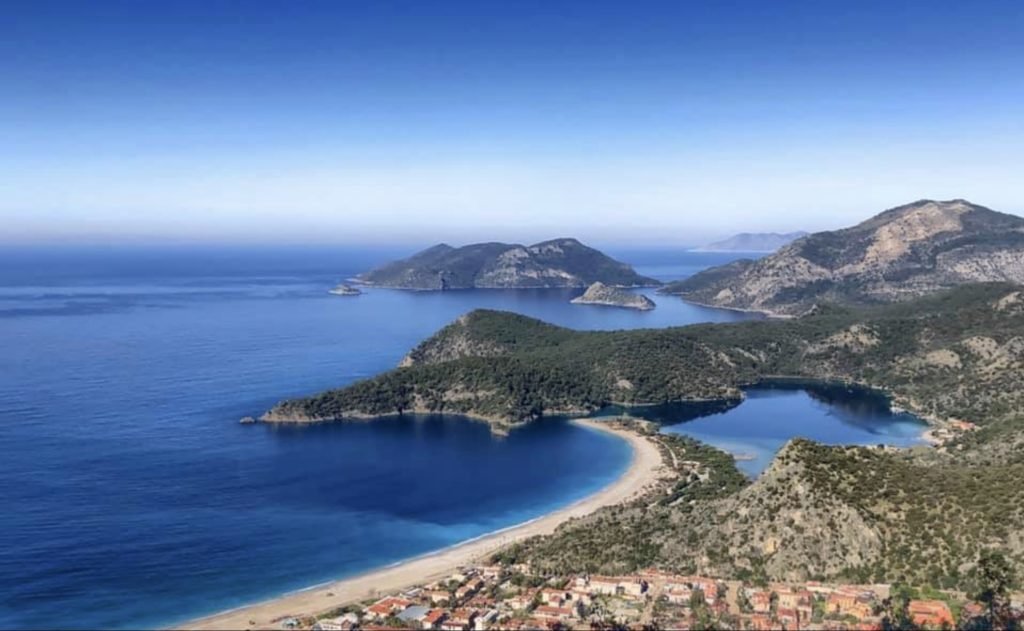
From the moment we left, we were captivated by hypnotic landscapes on the turquoise coast of Turkey. You can see the Greek island of Rhodes here in the distance.

When we weren’t lured by sapphire waters and islands, we turned around to soak in snow-capped mountains and forests…views easily reminiscent of the pacific NW, but who knew they existed in Turkey!

Fortunately on the trail we found an ample supply of fresh water springs bubbling from the mountains so we never had to carry too much water, just refill every time you come across one and you’ll be fine!

More beautiful scenery which looked reminiscent of our PNW home
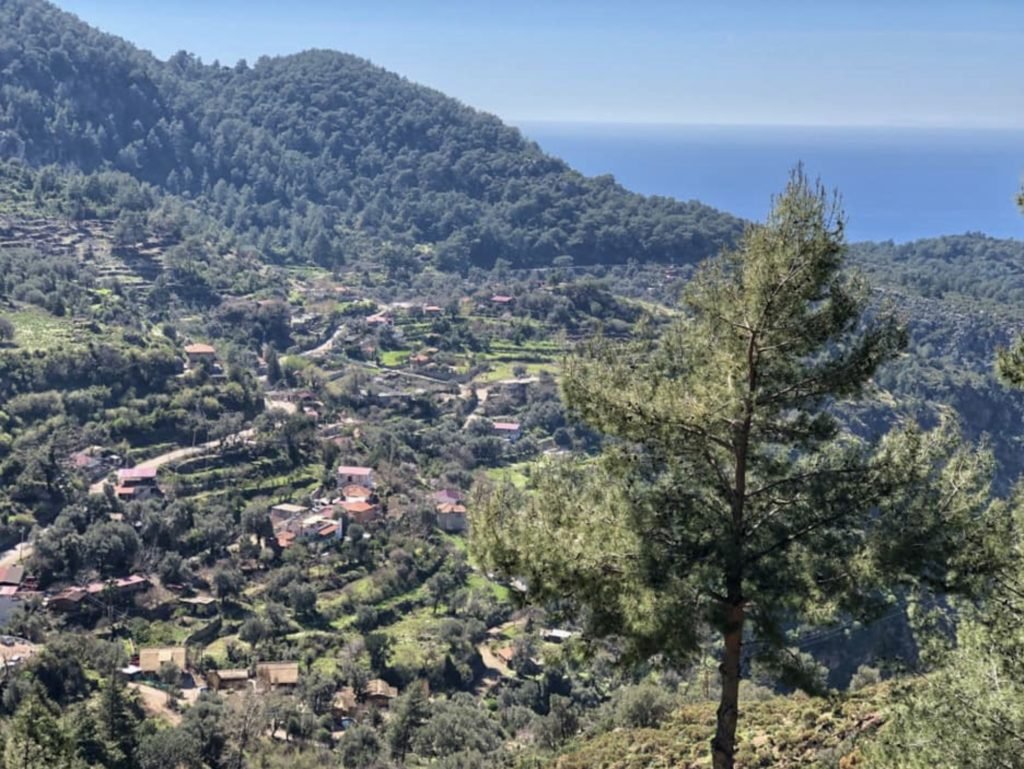
But not this! The terraced villages going down to the sea were just breathtaking. This was coming down the mountain slope for our first night’s stay in the village of Faralya. Many of the pensions were still closed for the season, because “hiking season” doesn’t officially begin until late March here, although the current 60/70 degree weather seems pretty ideal to us!

We settled into the Keyif Traveler’s Hotel for the night and because we were the only ones there, we got the best room with a killer view for half the cost.
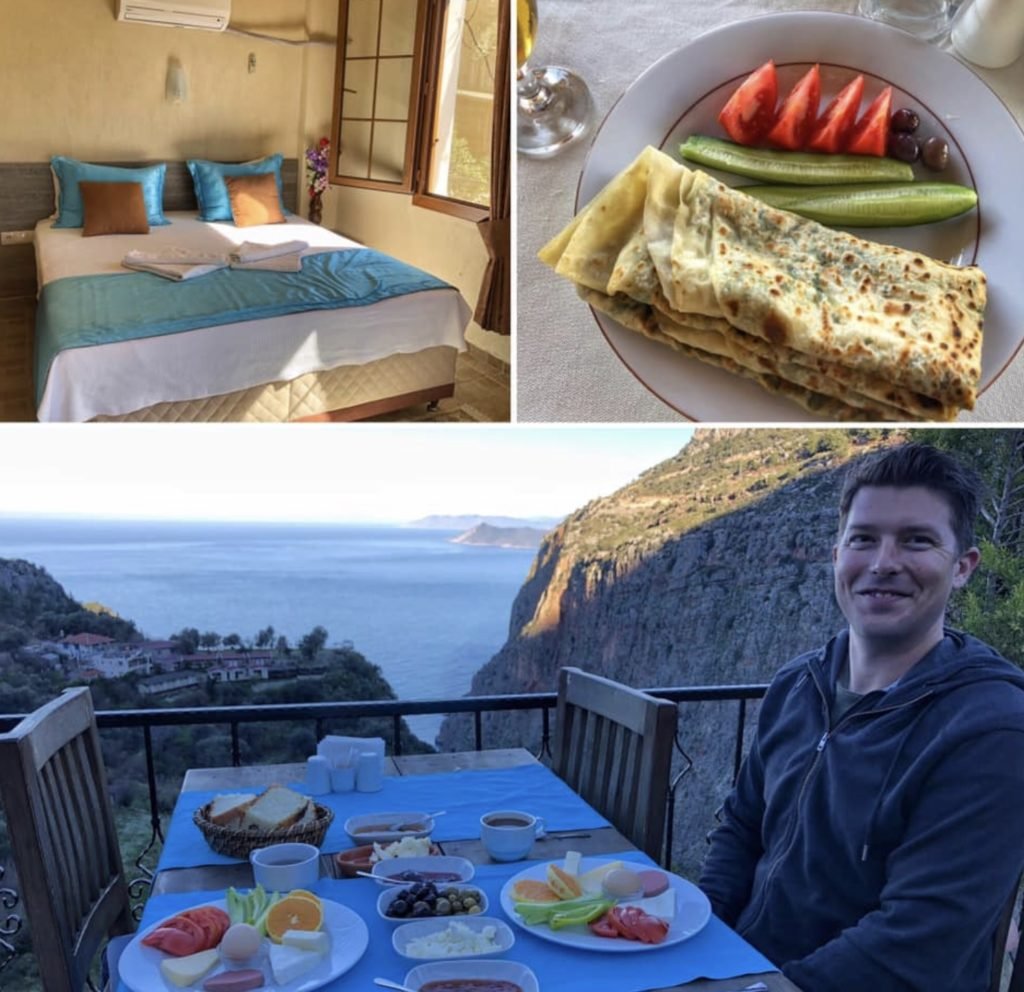
All rooms on the trail, which we didn’t need to reserve in advance, included half-board (dinner and breakfast) and cost 140-250 Turkish Lira ($25-$45) for the both of us. The food was amazing! One meal we had repeatedly was gozleme, or Turkish pancakes which are crepe-like in texture and stuffed with spinach and cheese. A typical Turkish breakfast includes all organic and locally made ingredients including jams, breads, olives, oranges, boiled eggs, tomatoes, cucumbers and cheese.

We were delighted to find lots of turtles meandering their way down the mountain trails…

…rope ladders…

And plentiful golden beaches (this one in Faralya can only be accessed via aforementioned rope ladder) or boat.

We walked through some lovely mountain meadows that second day…

…and started really understanding why this area is known as the Turquoise Coast…

…as we passed by uncountable orange and lemon trees. We had the best oranges of our lives…for free!!
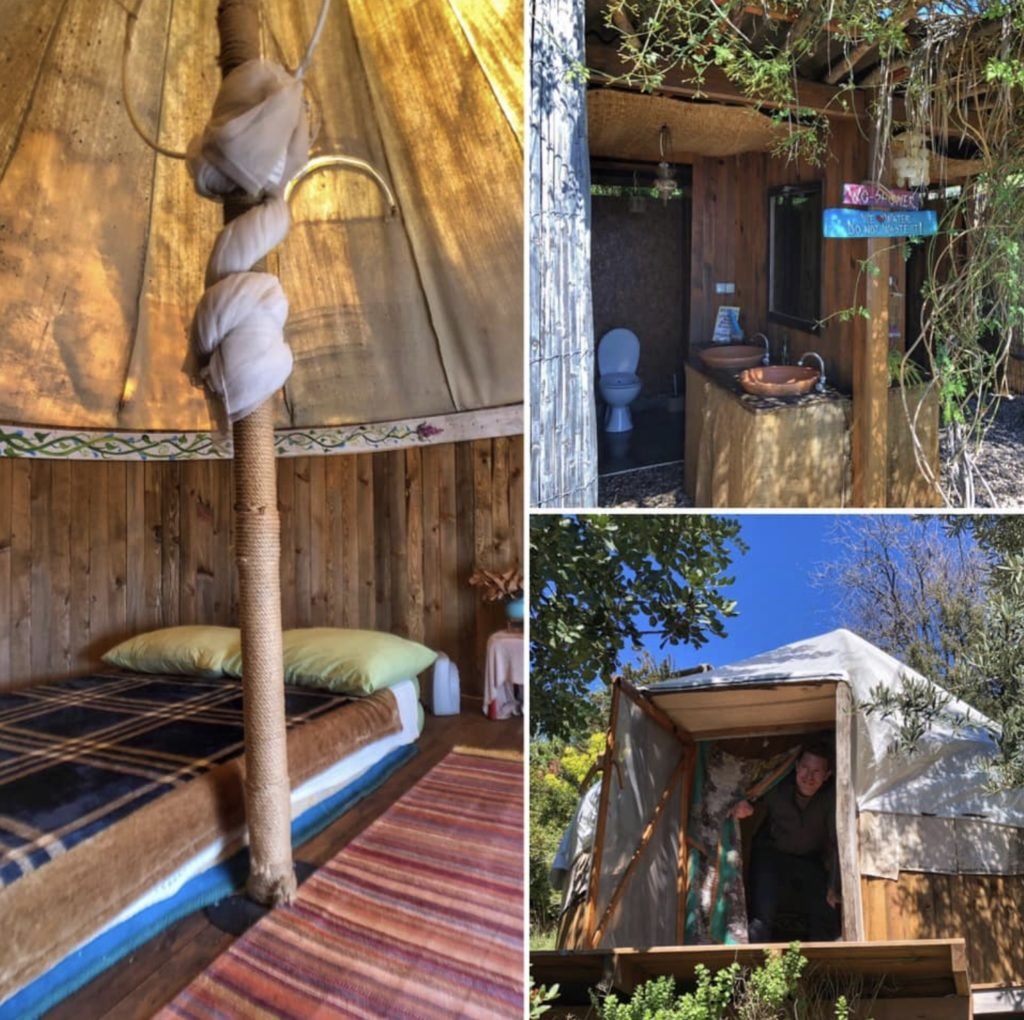
For our 3rd night we landed in the village of Kabak which was the site of our favorite accommodation on the trek, a place called Kok Kamp. We snagged a cozy little yurt on the hillside, which included a snooze inducing echo from the waves far below.

Lots of places to relax at Kok Kamp.

And the beach below, a quick 15 minute walk down the steep hill.
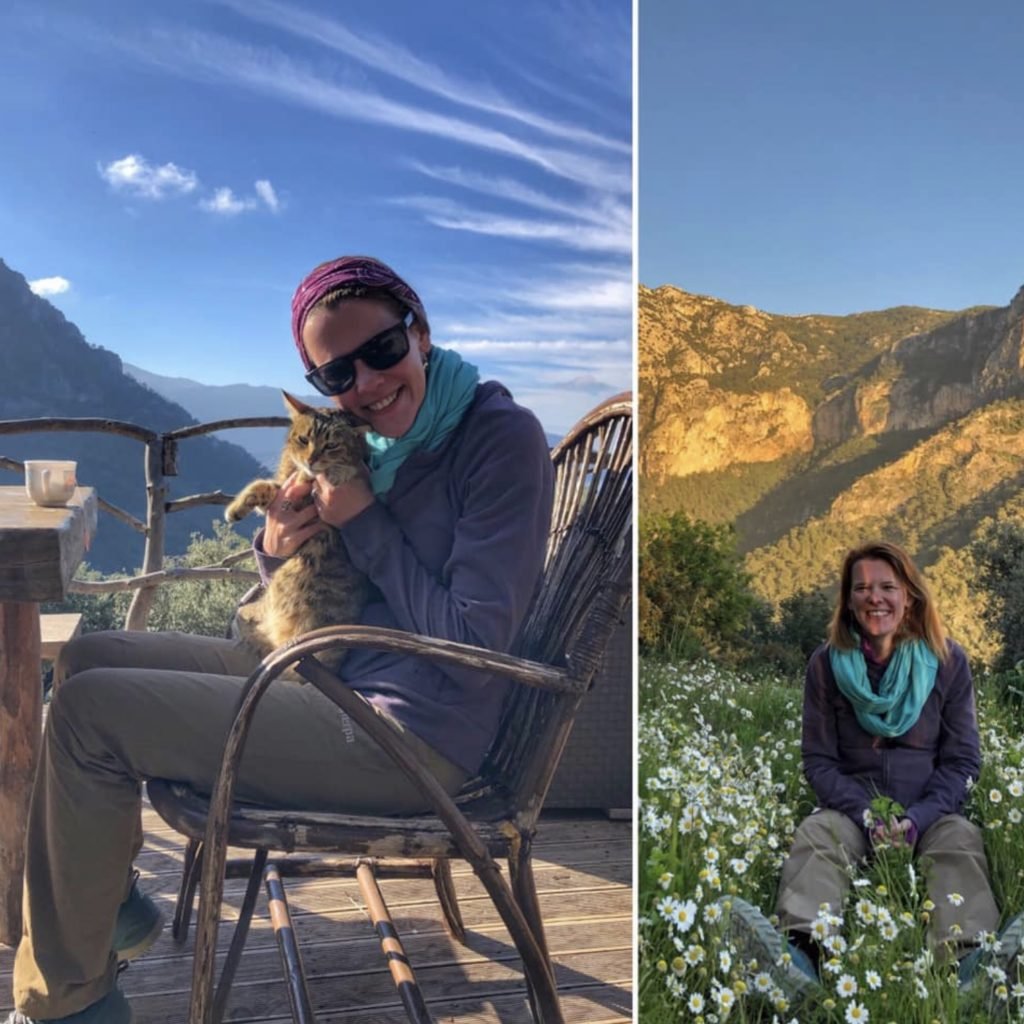
Coffee and kitties with a view! Mandy plops down in a sea of wildflowers.

As we got further into the mountains, some of the huge cliff faces reminded us of backcountry Yosemite. But again, Yosemite doesn’t offer sea or goat views. 😉

And with a few more tropical plants, this view could easily also be Hawaii.

Stumbling upon ancient Lycian ruins is common on the trail, some dating from pre-Roman times of 500 BC. This cistern was one of the many ruins we couldn’t stop gazing at.

Mountains and valleys.
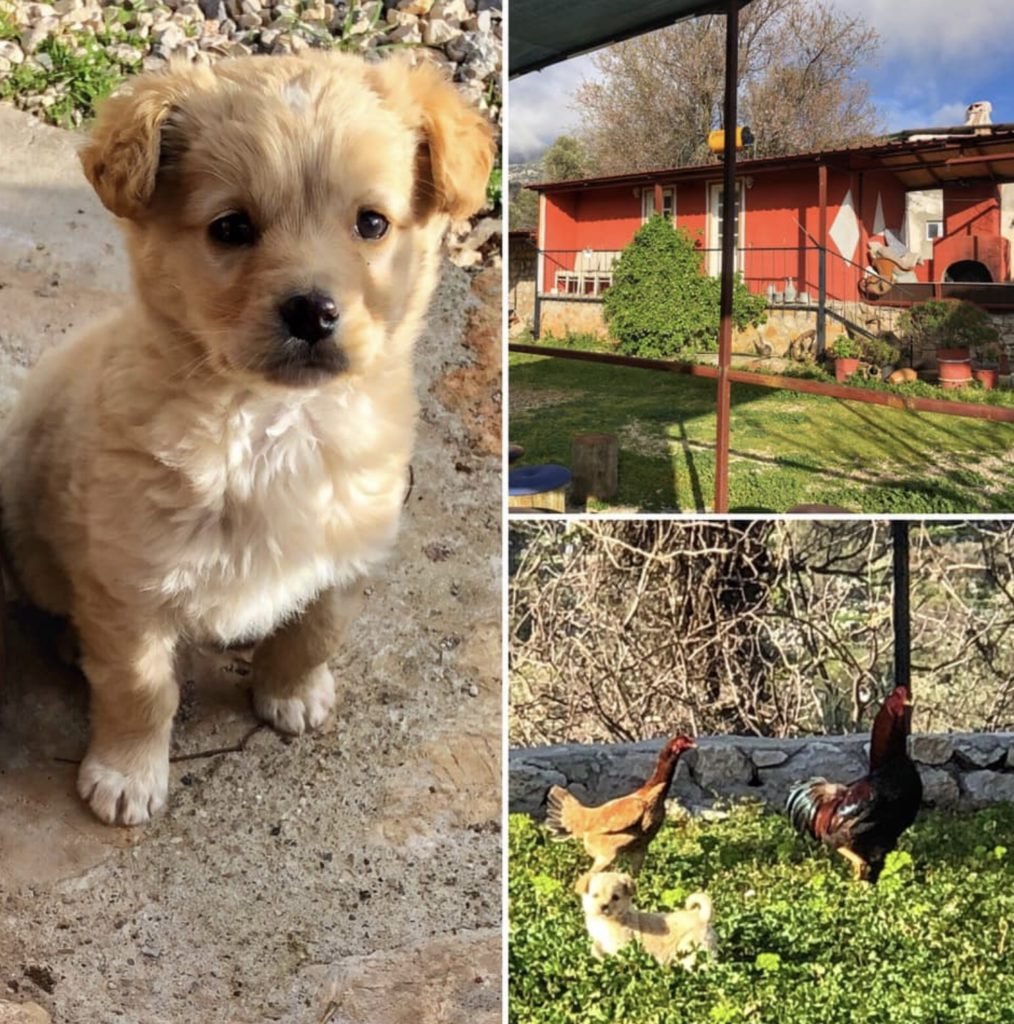
On night three, we ran into this ferocious beast who liked to torment ignorant chickens and steal the eggs. According to one of our hosts, he was “bad baby dog?!” We enjoyed viewing his antics from our pension, in the top right.
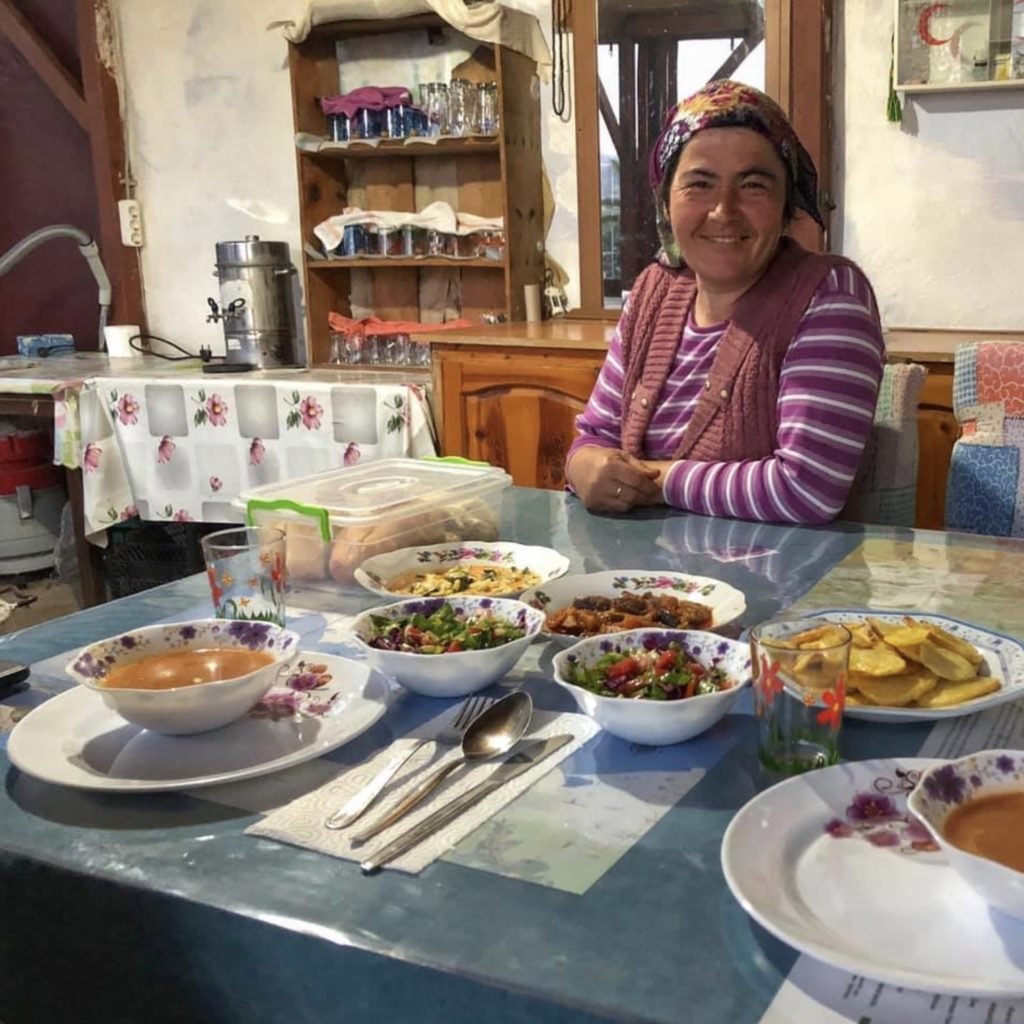
One of our hostesses showing off our delightful home-cooked vegetarian meal.

If you’re looking for tastes of the rainbow, spring is the time to walk the Lycian Way to see these vibrant and colorful wildflowers…
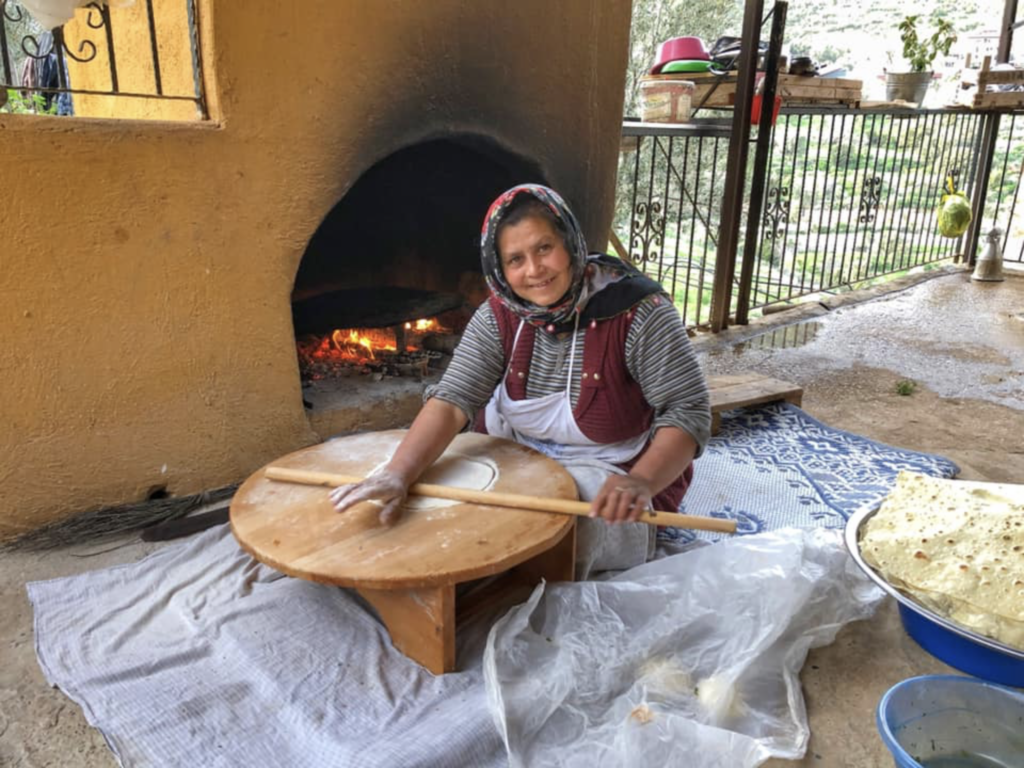
Another one of our adorable pension hostesses, sweet Fatma, making the bread for gozleme pancakes. She wouldn’t stop feeding us as she giggled like a gremlin. So cute.
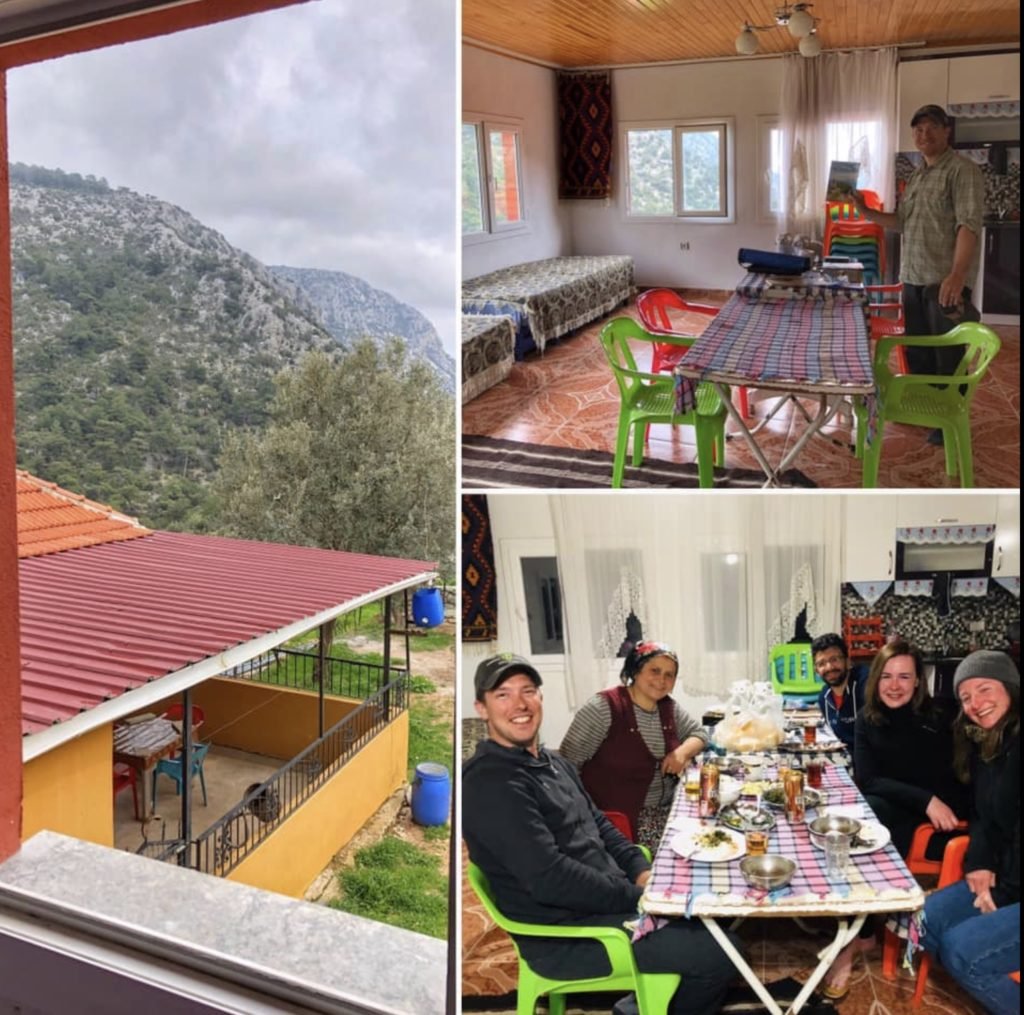
The view and space at Fatma’s pension for our 5th night. This was one of the few nights on the practically empty trail where we actually got to enjoy the company of other guests…two German gals and a Turkish guy who was hiking the Lycian for the second time in a year!

Another super cute bungalow we stayed in on the beach. This one had a fancy loft!

Can’t get enough Mediterranean sunsets!

Another terrain we were surprised to trek through on this trail…marsh and wetlands. The explosion of spring flowers really added to the experience.

On Parts of the trail you actually hike and climb through Lycian ruins like this fortress, top left at Pydnee or Xanthos. Finds of this ancient city date back to 8th Century BC. Many of these areas markedly seem to have a Roman theatre, which came years later as the Romans made their mark upon the Lycian society.

Arriving to the quaint little village of Gelemiş and accompanying Patara ruins and its glorious beach, we decided this was the ideal place to hang out a couple of days, and rest our weary bones. Gelemiş, like other villages, was nearly completely empty of tourists in March, and to us, it had a little bit of a Central American feel. We loved it.

The 2500-year-old Lycian ruins at Patara are some of the most notable on the trail. This city was once a major naval and trading port of Lycia. It grew to a city of 20,000 during Roman times during 2nd Century AD. Much of the ruins are still undiscovered under the sand and excavations have been in progress since 1950. You can see all of the “unprocessed” stone fragments that lay like a jigsaw puzzle in the field. Imagine trying to put that puzzle together!!

In Christian history, Patara was famous for being a place of St. Paul’s missionary work at the end of his third missionary journey. Patara was also the birthplace of St Nicholas, (born c.260-280 AD), bishop of Myra and the future Santa Claus.

Patara Beach, next to the ruins, is a remarkable 12k long sandy stretch of the most inviting beach and sea we’ve ever seen. In fact it was voted one of the most beautiful beaches in the world by the Times Online. It clearly earned that title.

The Lycian Way is a standout as one of the best longer distance treks we’ve ever done! Simply extraordinary if you ever get the chance!

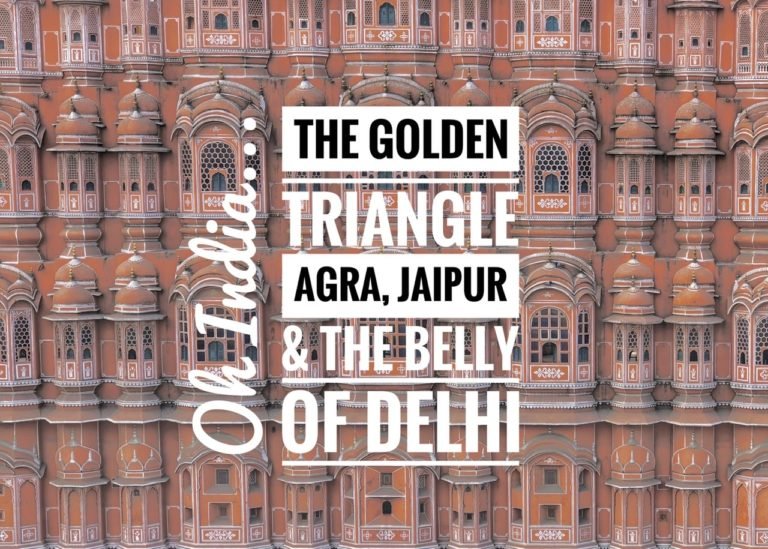


Hi! Enjoyed reading your account of the Lycian Way!
We are planning to go early 2025 and wanted to know what the best month would be to see the spring wildflowers?
With thanks
Hi Deb! Thanks for your message. Good for you. It’s a phenomenal trail! Still one of our favs to this day. They were gorgeous when we went in late March, probably well into April as well!
Have an amazing time!
Mandy & Greg